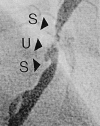New developments in percutaneous coronary intervention
- PMID: 12869460
- PMCID: PMC1126511
- DOI: 10.1136/bmj.327.7407.150
New developments in percutaneous coronary intervention
Figures










Similar articles
-
ABC of interventional cardiology: percutaneous coronary intervention. I: history and development.BMJ. 2003 May 17;326(7398):1080-2. doi: 10.1136/bmj.326.7398.1080. BMJ. 2003. PMID: 12750213 Free PMC article. Review. No abstract available.
-
[Percutaneous coronary intervention: Current status of the development of new devices and the perspective of their future].Nihon Rinsho. 2003 Apr;61 Suppl 4:529-33. Nihon Rinsho. 2003. PMID: 12735028 Review. Japanese. No abstract available.
-
ABC of interventional cardiology: percutaneous coronary intervention. II: the procedure.BMJ. 2003 May 24;326(7399):1137-40. doi: 10.1136/bmj.326.7399.1137. BMJ. 2003. PMID: 12763994 Free PMC article. Review. No abstract available.
-
[Laser coronary angioplasty].Nihon Rinsho. 2003 Apr;61 Suppl 4:540-8. Nihon Rinsho. 2003. PMID: 12735030 Review. Japanese. No abstract available.
-
Progress in interventional cardiology. Restenosis after elective percutaneous transluminal coronary angioplasty.J Interv Cardiol. 1992 Sep;5(3):245-51. doi: 10.1111/j.1540-8183.1992.tb00432.x. J Interv Cardiol. 1992. PMID: 10150962 Review. No abstract available.
Cited by
-
Percutaneous transluminal coronary angioplasty with stents versus coronary artery bypass grafting for people with stable angina or acute coronary syndromes.Cochrane Database Syst Rev. 2005 Jan 25;2005(1):CD004588. doi: 10.1002/14651858.CD004588.pub3. Cochrane Database Syst Rev. 2005. PMID: 15674954 Free PMC article.
References
-
- Morice M-C, Serruys PW, Sousa JE, Fajadet J, Ban Hayashi E, Perin M, et al. A randomized comparison of a sirolimus-eluting stent with a standard stent for coronary revascularization. N Engl J Med 2002;346: 1773-80 - PubMed
-
- Park SJ, Shim WH, Ho DS, Raizner AE, Park SW, Hong MK, et al. A paclitaxel-eluting stent for the prevention of coronary restenosis. N Engl J Med 2003;348: 1537-45 - PubMed
-
- Raco DL, Yusuf S. Overview of randomised trials of percutaneous coronary intervention: comparison with medical and surgical therapy for chronic coronary artery disease. In: Grech ED, Ramsdale DR, eds. Practical interventional cardiology. 2nd ed. London: Martin Dunitz, 2002: 263-77
-
- Teirstein PS, Kuntz RE. New frontiers in interventional cardiology: intravascular radiation to prevent restenosis. Circulation 2001;104: 2620-6 - PubMed
-
- Tsuji T, Tamai H, Igaki K, Kyo E, Kosuga K, Hata T, et al. Biodegradable stents as a platform to drug loading. Int J Cardiovasc Intervent 2003;5: 13-6 - PubMed
Publication types
MeSH terms
LinkOut - more resources
Full Text Sources
Other Literature Sources
